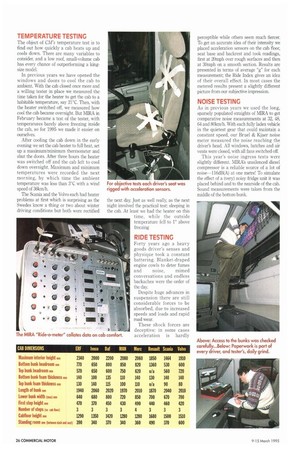D espite the hest efforts of the Government there's no escaping
Page 26

Page 28

If you've noticed an error in this article please click here to report it so we can fix it.
inflation. Just look at truck cabs: they seem to be getting bigger by the month. A few years ago the skyscraper front of the Renault Magnum dwarfed every other truck on the road—now it's in danger of looking a bit weedy against giants like MAN's Roadhaus and Leyland Daf's Super Space Cab.
Each manufacturer wants a flagship model to outgun the opposition, but the trend towards big cabs is also a response to the growing demand for trans-European transport. So CM offers no excuses for again testing Europe's highest, widest and most handsome trucks in our 1995 Sleeper Cab Test.
This year's Cab Test is also the biggest we've done: we assembled eight premium tractive units at the Motor Industry Research Association proving ground near Nuneaton, along with several laden trailers, a raft of test equipment and eight willing(ish) staffers to find out which of these wagons gave the best night's sleep.
As usual Mother Nature lent a hand by ensuring that we had the foulest conditions possible for the test with TIIE CABS The most highly publicised new cab design for years has been Leyland Dal's 95-Series Super Space Cab, touted as the biggest and most comfortable around—not to mention the yellowest. It's available with Dafbuilt engines from 360hp upwards, but we tested it with the 500hp Cummins Celect N500E—a combination sold as the ideal way to tackle the run to Moscow and beyond.
One of the other big launches this year will be MAN's F2000 series, replacing the F90. We tested the big F90 Roadhaus in last year's Sleeper
TEMPERATURE TESTING
The object of CM'S temperature test is to find out how quickly a cab heats up and cools down. There are many variables to consider, and a low roof, small-volume cab has every chance of outperforming a kingsize model.
In previous years we have opened the windows and doors to cool the cab to ambient. With the cab closed once more and a willing tester in place we measured the time taken for the heater to get the cab to a habitable temperature, say 21°C. Then, with the heater switched off, we measured how cool the cab became overnight. But MIRA in February became a test of the tester, with temperatures barely above freezing inside the cab, so for 1995 we made it easier on ourselves.
After cooling the cab down in the early evening we set the cab heater to full heat, set up a maximum/minimum thermometer and shut the doors. After three hours the heater was switched off and the cab left to cool down overnight. Maximum and minimum temperatures were recorded the next morning, by which time the ambient temperature was less than 3°C with a wind speed of 36km/h.
The Scania and the Volvo each had heater problems at first which is surprising as the Swedes know a thing or two about winter driving conditions but both were rectified
the next day. Just as well really, as the next night involved the practical test: sleeping in the cab. At least we had the heater on this time, while the outside temperature fell to 10 above freezing
RIDE TESTING
Forty years ago a heavy goods driver's senses and physique took a constant battering. Blanket-draped engine cowls to deter fumes and noise, mimed conversations and endless backaches were the order of the day.
Despite huge advances in suspension there are still considerable forces to be absorbed, due to increased speeds and loads and rapid road wear.
These shock forces are
perceptible while others seem much fiercer. To get an accurate idea of their intensity we placed acceleration sensors on the cab floor, seat base and backrest and took readings, first at 20mph over rough surfaces and then at 30mph on a smooth section. Results are presented in terms of average "g" for each measurement; the Ride Index gives an idea of their overall effect. In most cases the metered results present a slightly different picture from our subjective impression.
NOISE TESTING
As in previous years we used the long, sparsely populated straights of MIRA to get comparative noise measurements at 32, 48, 64 and 80km/h. With each fully laden vehicle in the quietest gear that could maintain a constant speed, our Bruel & Kjaer noise meter measured the noise reaching the driver's head. All windows, hatches and air vents were closed, with all fans switched off.
This year's noise ingress tests were slightly different. MIRA's unsilenced diesel compressor is a reliable source of a lot of noise-116c1B(A) at one metre? To simulate the effect of a (very) noisy fridge unit it was placed behind and to the nearside of the cab. Sound measurements were taken from the middle of the bottom bunk.
































































































